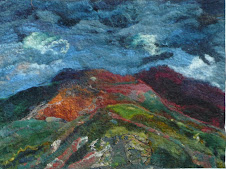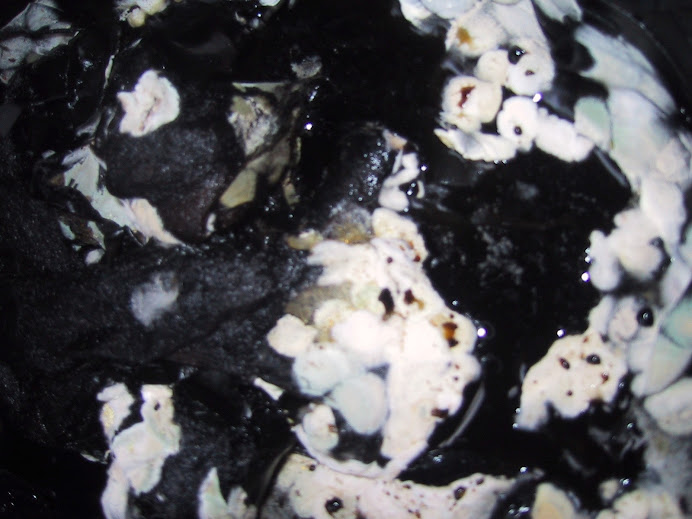You can see that one half of this little vat is thick yellowy solid deposit. The liquid half is a deep orange almost red. I took 100ml out of this yesterday which is why there appears to be a cloudy blue bit in fact is empty with a bit of a deposit on the glass. .
Today thanks to help from Debbie and Jane and Leena I managed the fructose indigo vat.
I heated 3 litres of water to 80 degrees C, tipped the contents of the little 400ml vat in and stirred. Within 30 seconds flakes of blue appeared on the yellowy looking surface then a thick blue indigo flower. After ten minutes the colour of the water under the filmy surface was a lime green then a orangey yellow. ( the colours of this type of vat seem different to that of the chemical reduction vat using thiourea dioxide.
The vat was at pH 10 and dye dyed well the temperature dropped to 45 degrees,d dying cotton velvet then a length of merino tops a pale blue. . I dipped the cotton velvet into the vat 3 times and got a slightly deeper blue but I don't seem to have photographed it. You don't seem to need to dip the fibres for very long. Quite literally in and out. The colour change is either very slow or the stuff comes out blue and I need to go back to this vat and see if I can work out why this is. Is the stuff coming out blue in the vat longer? And as you can see there is a yellowy scum on the surface which washed off which I assume is the deposit form the bottom of the vat. I wonder if these fibres will crock.
Nb It would seem that you can make a stock solution just as we do with the thiourea vat which could I think be very useful
Today thanks to help from Debbie and Jane and Leena I managed the fructose indigo vat.
I heated 3 litres of water to 80 degrees C, tipped the contents of the little 400ml vat in and stirred. Within 30 seconds flakes of blue appeared on the yellowy looking surface then a thick blue indigo flower. After ten minutes the colour of the water under the filmy surface was a lime green then a orangey yellow. ( the colours of this type of vat seem different to that of the chemical reduction vat using thiourea dioxide.
The vat was at pH 10 and dye dyed well the temperature dropped to 45 degrees,d dying cotton velvet then a length of merino tops a pale blue. . I dipped the cotton velvet into the vat 3 times and got a slightly deeper blue but I don't seem to have photographed it. You don't seem to need to dip the fibres for very long. Quite literally in and out. The colour change is either very slow or the stuff comes out blue and I need to go back to this vat and see if I can work out why this is. Is the stuff coming out blue in the vat longer? And as you can see there is a yellowy scum on the surface which washed off which I assume is the deposit form the bottom of the vat. I wonder if these fibres will crock.
Nb It would seem that you can make a stock solution just as we do with the thiourea vat which could I think be very useful

















































